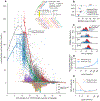Protein-coding repeat polymorphisms strongly shape diverse human phenotypes
- PMID: 34554798
- PMCID: PMC8549062
- DOI: 10.1126/science.abg8289
Protein-coding repeat polymorphisms strongly shape diverse human phenotypes
Abstract
Many human proteins contain domains that vary in size or copy number because of variable numbers of tandem repeats (VNTRs) in protein-coding exons. However, the relationships of VNTRs to most phenotypes are unknown because of difficulties in measuring such repetitive elements. We developed methods to estimate VNTR lengths from whole-exome sequencing data and impute VNTR alleles into single-nucleotide polymorphism haplotypes. Analyzing 118 protein-altering VNTRs in 415,280 UK Biobank participants for association with 786 phenotypes identified some of the strongest associations of common variants with human phenotypes, including height, hair morphology, and biomarkers of health. Accounting for large-effect VNTRs further enabled fine-mapping of associations to many more protein-coding mutations in the same genes. These results point to cryptic effects of highly polymorphic common structural variants that have eluded molecular analyses to date.
Figures




Update of
-
Protein-coding repeat polymorphisms strongly shape diverse human phenotypes.bioRxiv [Preprint]. 2021 Jan 19:2021.01.19.427332. doi: 10.1101/2021.01.19.427332. bioRxiv. 2021. Update in: Science. 2021 Sep 24;373(6562):1499-1505. doi: 10.1126/science.abg8289. PMID: 33501449 Free PMC article. Updated. Preprint.
Comment in
-
Missing heritability may be hiding in repeats.Science. 2021 Sep 24;373(6562):1440-1441. doi: 10.1126/science.abl7794. Epub 2021 Sep 23. Science. 2021. PMID: 34554784
References
-
- Sudmant PH, Rausch T, Gardner EJ, Handsaker RE, Abyzov A, Huddleston J, Zhang Y, Ye K, Jun G, Fritz MH-Y, Konkel MK, Malhotra A, Stütz AM, Shi X, Casale FP, Chen J, Hormozdiari F, Dayama G, Chen K, Malig M, Chaisson MJP, Walter K, Meiers S, Kashin S, Garrison E, Auton A, Lam HYK, Mu XJ, Alkan C, Antaki D, Bae T, Cerveira E, Chines P, Chong Z, Clarke L, Dal E, Ding L, Emery S, Fan X, Gujral M, Kahveci F, Kidd JM, Kong Y, Lameijer E-W, McCarthy S, Flicek P, Gibbs RA, Marth G, Mason CE, Menelaou A, Muzny DM, Nelson BJ, Noor A, Parrish NF, Pendleton M, Quitadamo A, Raeder B, Schadt EE, Romanovitch M, Schlattl A, Sebra R, Shabalin AA, Untergasser A, Walker JA, Wang M, Yu F, Zhang C, Zhang J, Zheng-Bradley X, Zhou W, Zichner T, Sebat J, Batzer MA, McCarroll SA, Mills RE, Gerstein MB, Bashir A, Stegle O, Devine SE, Lee C, Eichler EE, Korbel JO, An integrated map of structural variation in 2,504 human genomes. Nature (2015), doi:10.1038/nature15394. - DOI - PMC - PubMed
-
- Sulovari A, Li R, Audano PA, Porubsky D, Vollger MR, Logsdon GA, Human Genome Structural Variation Consortium, Warren WC, Pollen AA, Chaisson MJP, Eichler EE, Human-specific tandem repeat expansion and differential gene expression during primate evolution. Proc. Natl. Acad. Sci (2019), doi:10.1073/pnas.1912175116. - DOI - PMC - PubMed
-
- Lalioti MD, Scott HS, Buresi C, Rossier C, Bottani A, Morris MA, Malafosse A, Antonarakis SE, Dodecamer repeat expansion in cystatin B gene in progressive myoclonus epilepsy. Nature. 386, 847–851 (1997). - PubMed
-
- Wijmenga C, Hewitt JE, Sandkuijl LA, Clark LN, Wright TJ, Dauwerse HG, Gruter A-M, Hofker MH, Moerer P, Williamson R, van Ommen G-JB, Padberg GW, Frants RR, Chromosome 4q DNA rearrangements associated with facioscapulohumeral muscular dystrophy. Nat. Genet 2, 26–30 (1992). - PubMed
-
- Marchini J, Howie B, Myers S, McVean G, Donnelly P, A new multipoint method for genome-wide association studies by imputation of genotypes. Nat. Genet 39, 906–913 (2007). - PubMed
Publication types
MeSH terms
Substances
Grants and funding
LinkOut - more resources
Full Text Sources
Other Literature Sources
Research Materials
Miscellaneous

